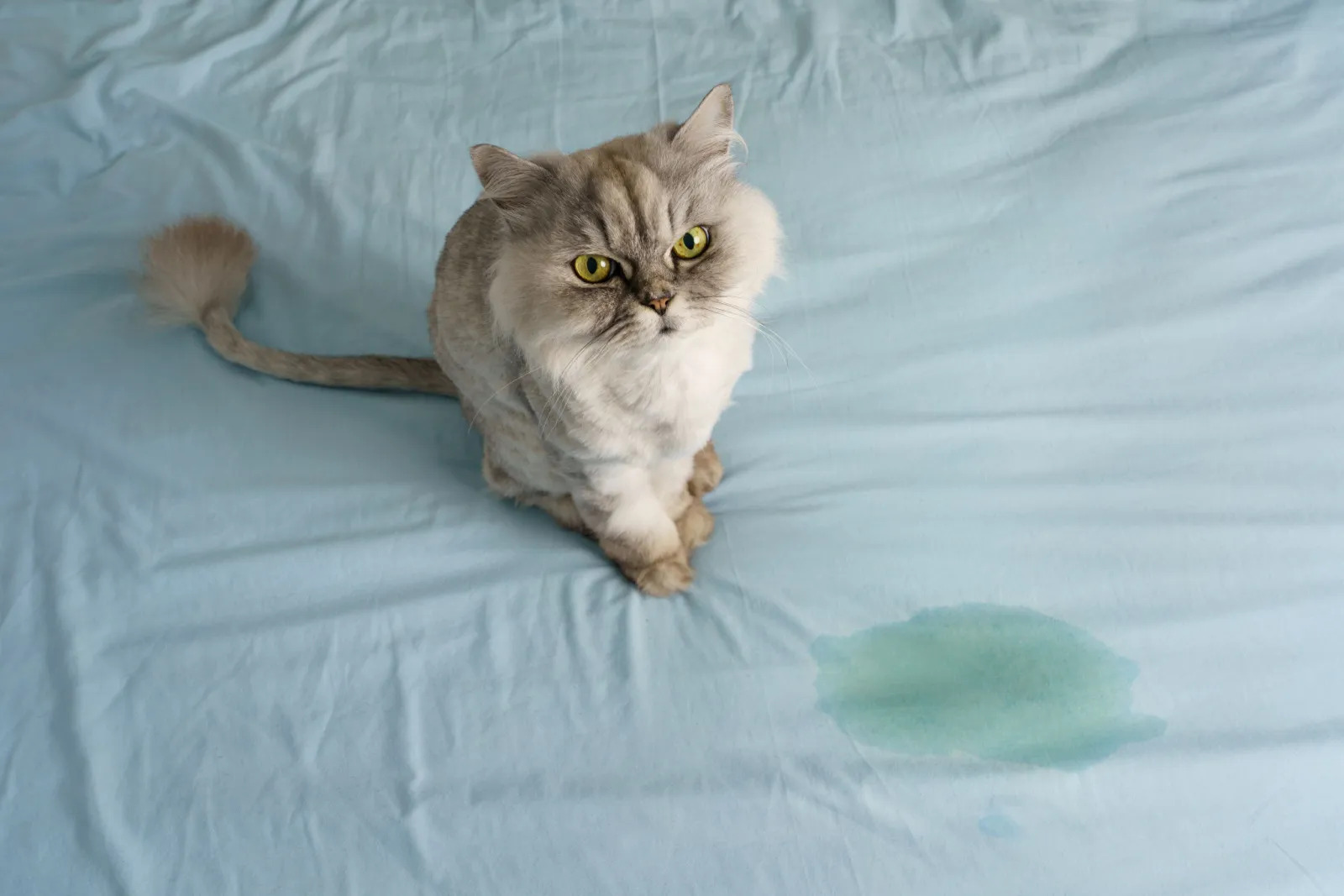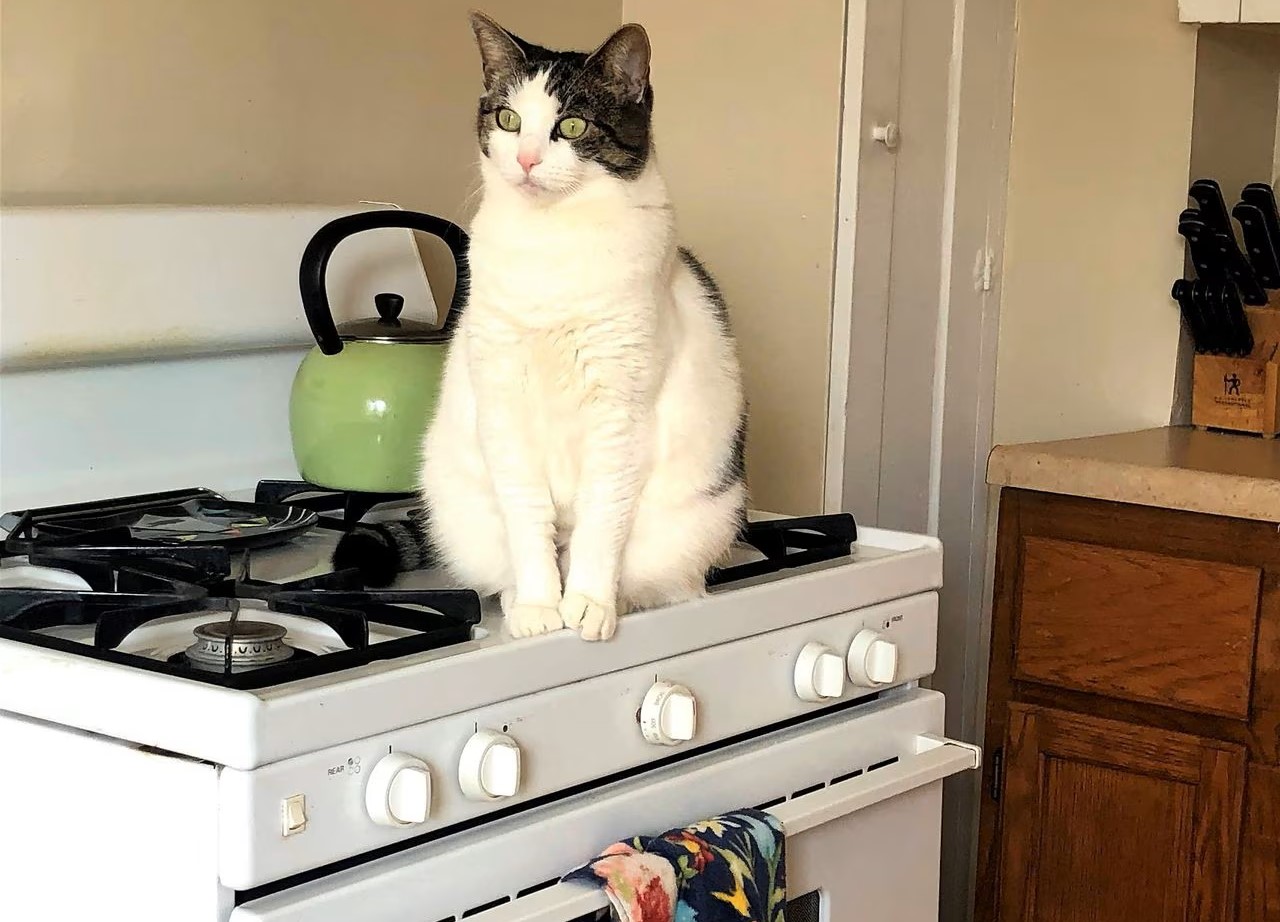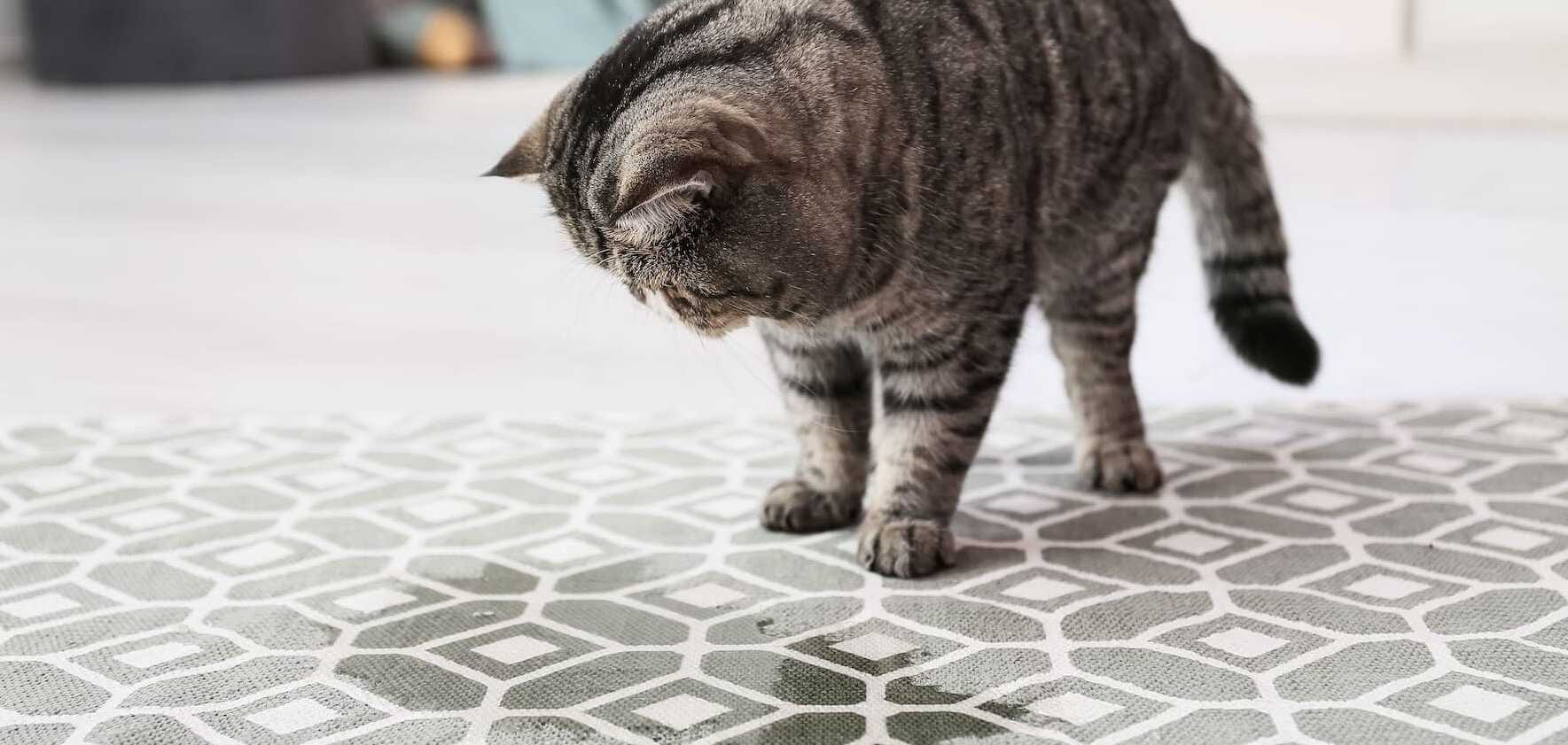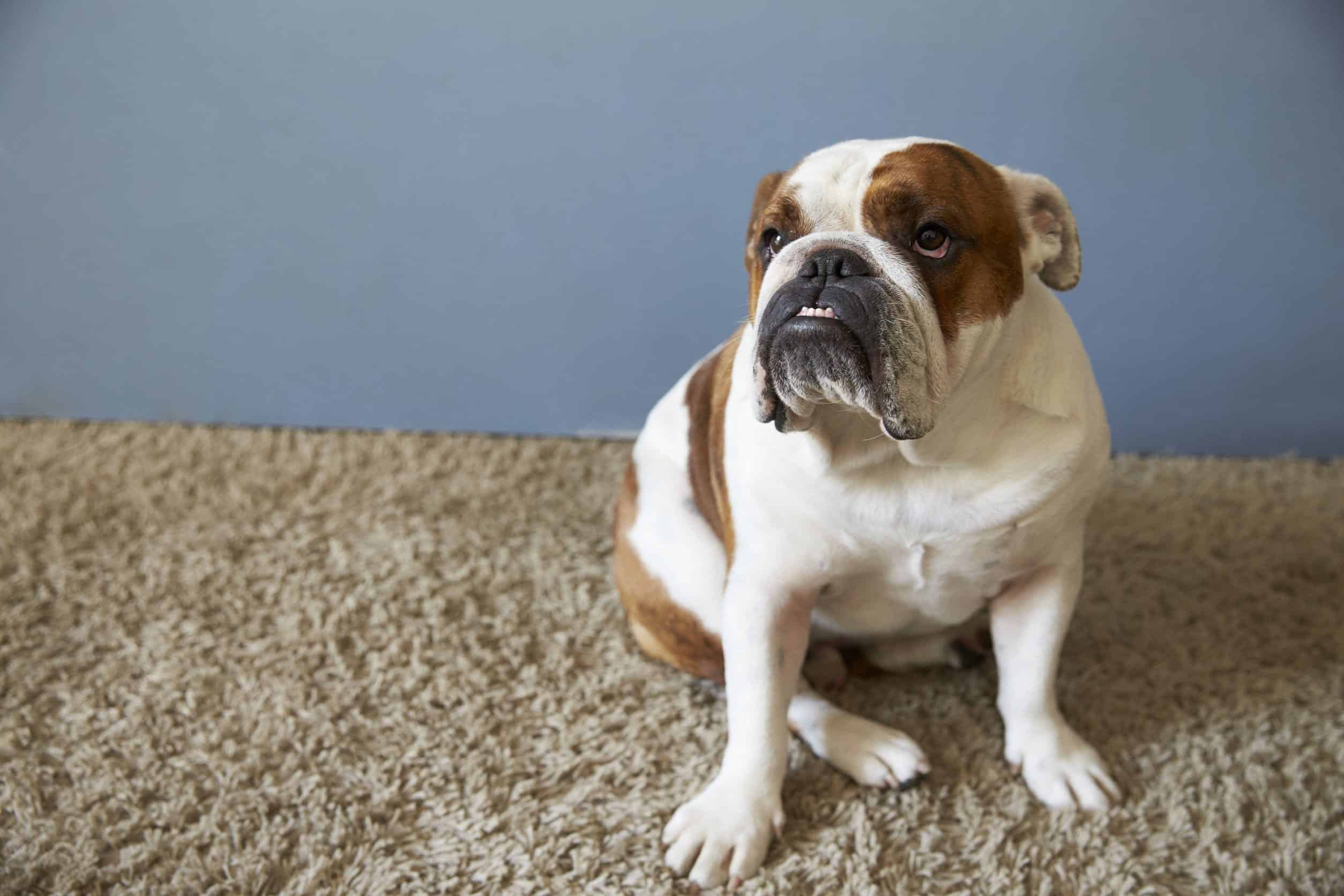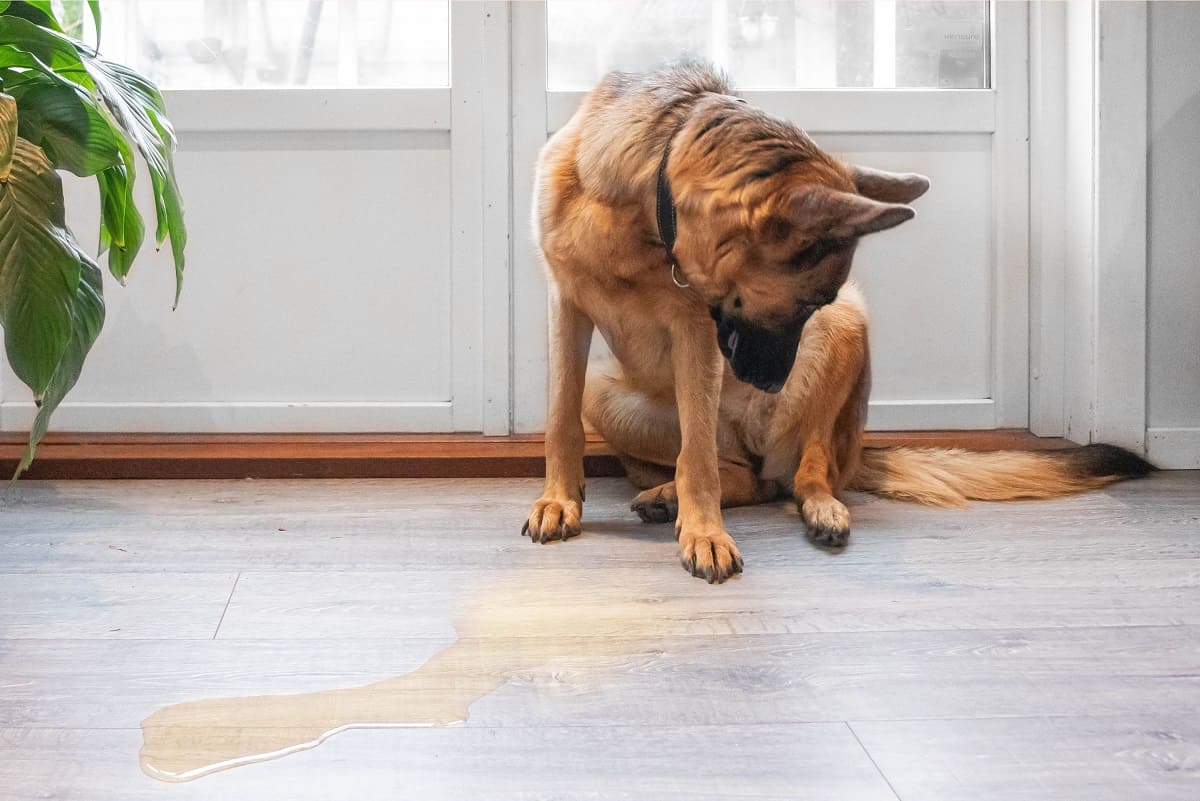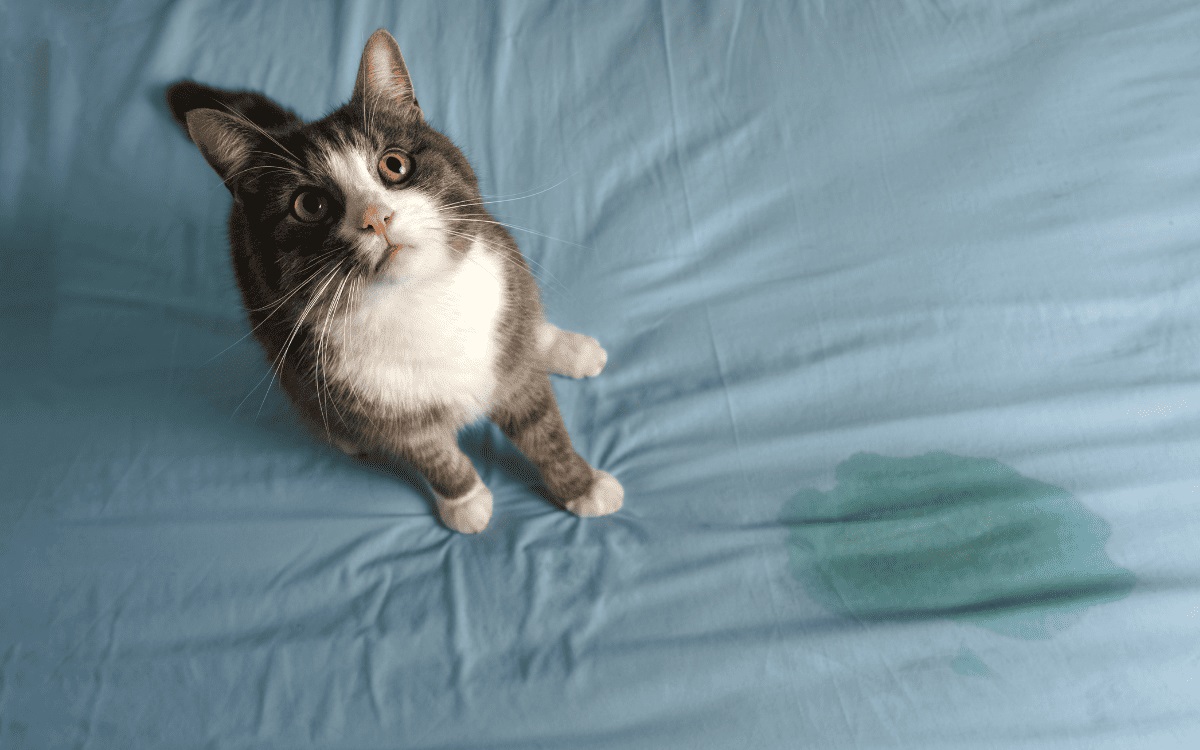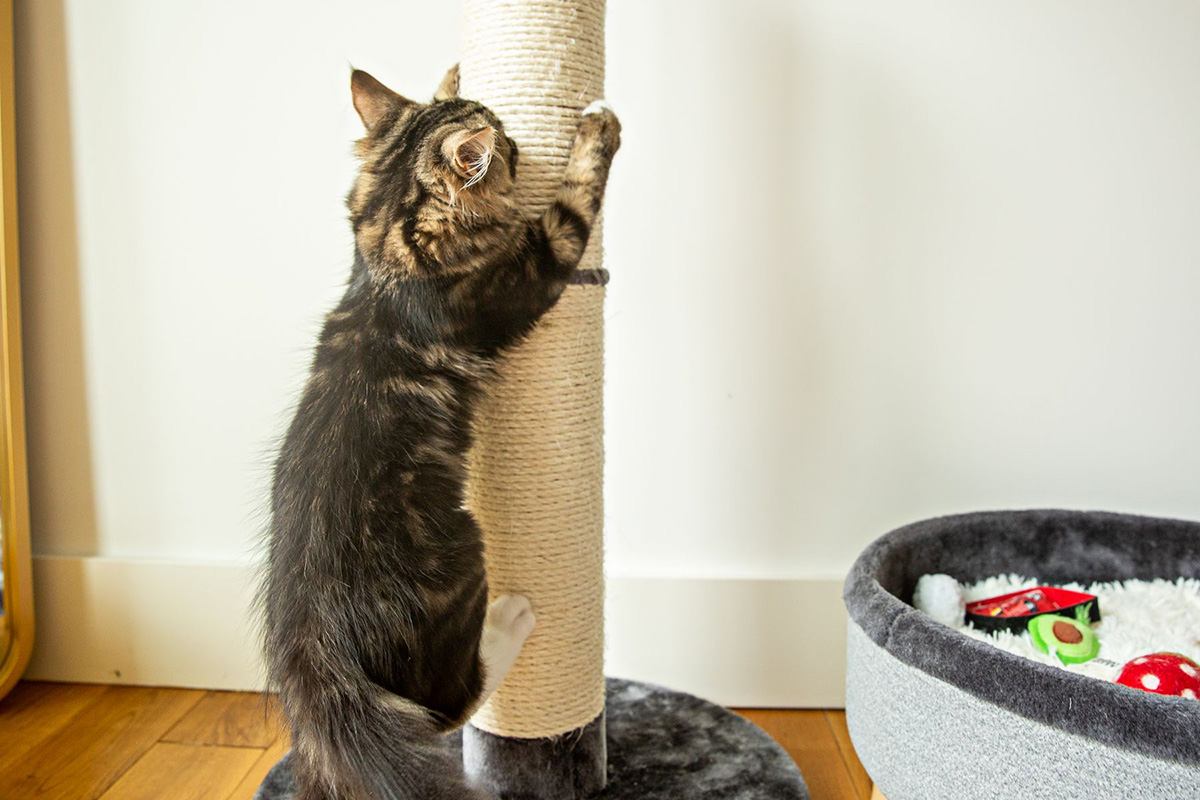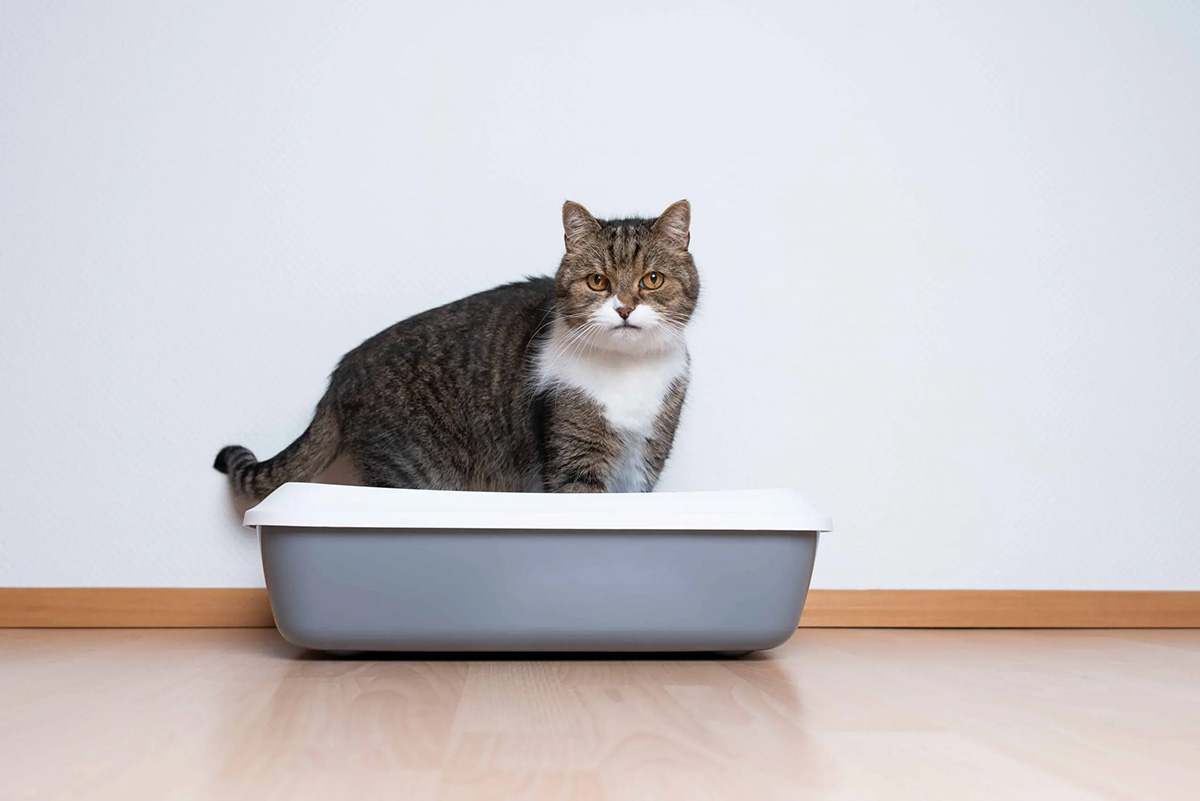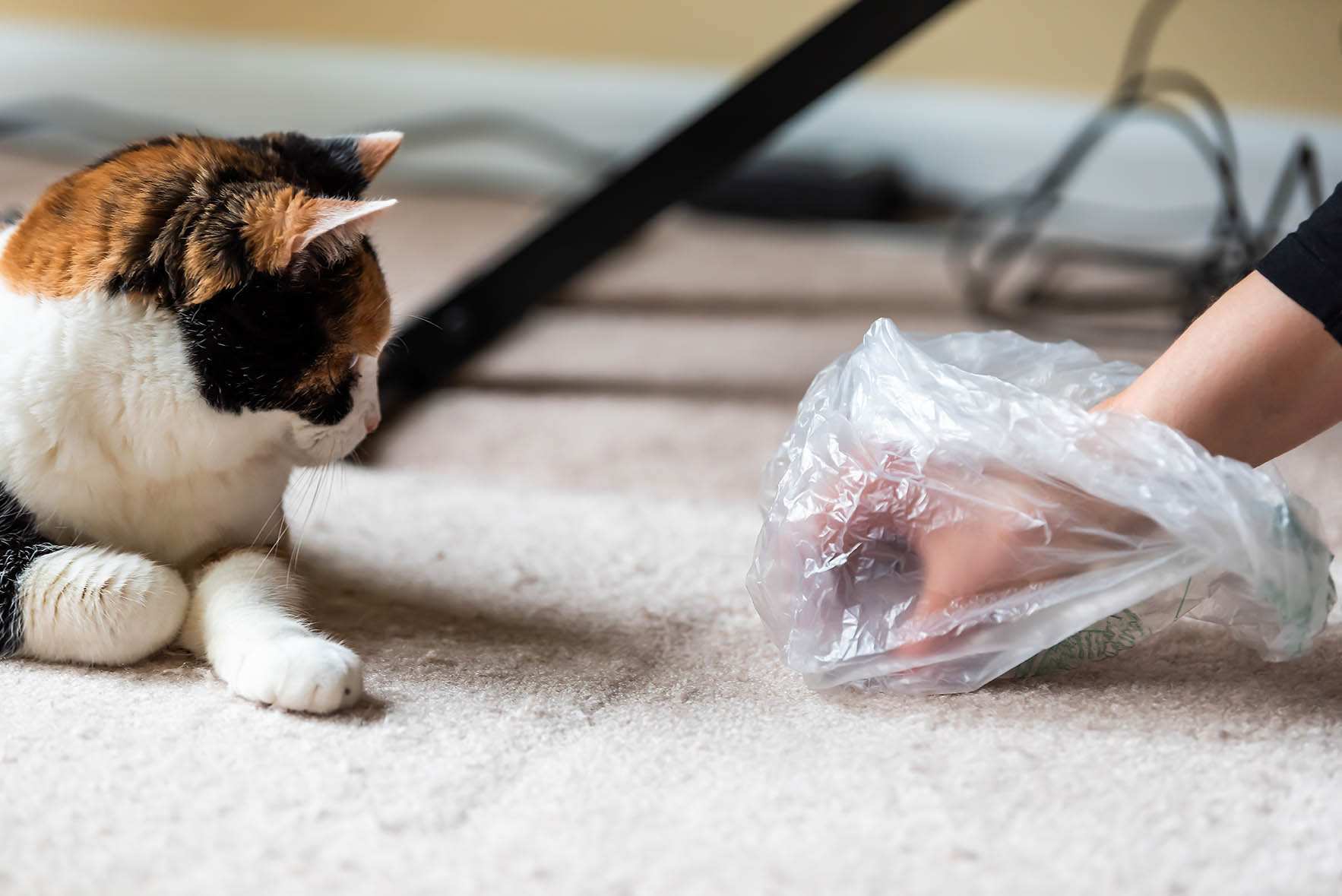Home>Furniture>Bedroom Furniture>How To Stop A Cat From Peeing On The Bed
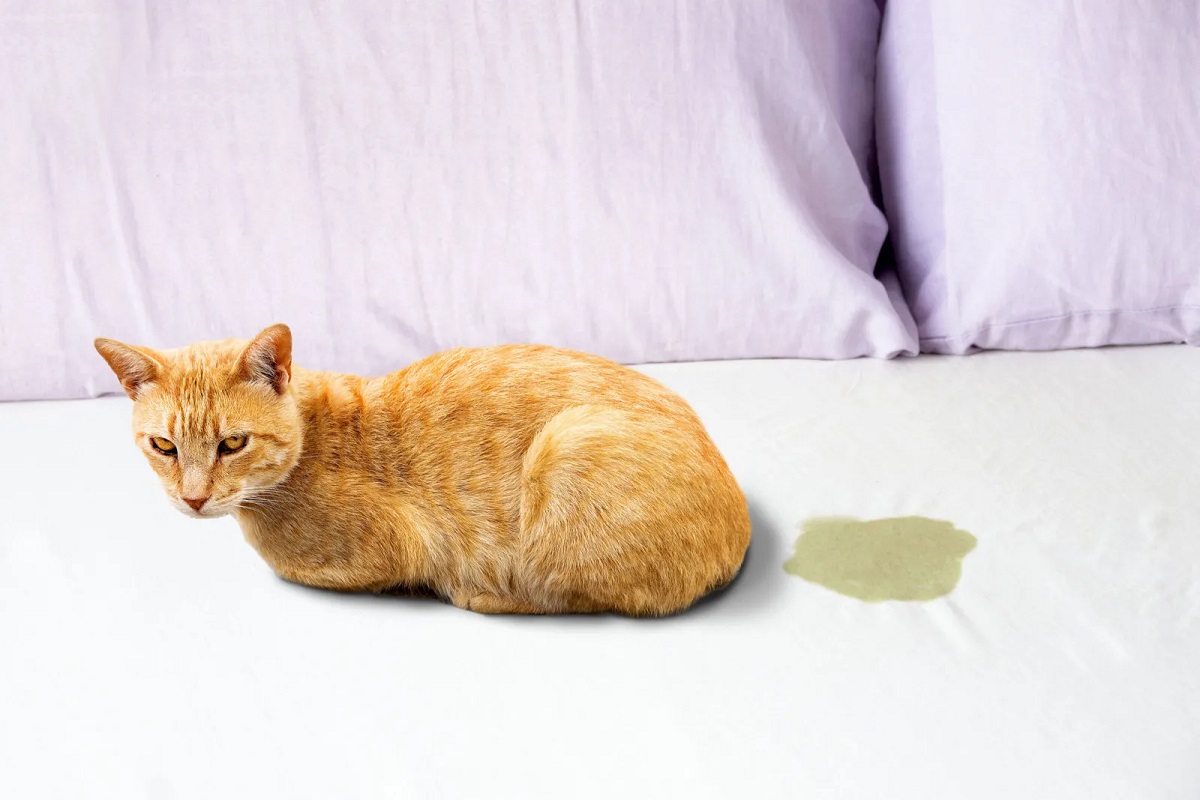

Bedroom Furniture
How To Stop A Cat From Peeing On The Bed
Modified: February 24, 2024
Learn effective methods to prevent your cat from peeing on the bed. Discover solutions for bedroom furniture and maintain a clean, odor-free space.
(Many of the links in this article redirect to a specific reviewed product. Your purchase of these products through affiliate links helps to generate commission for Storables.com, at no extra cost. Learn more)
Introduction
Welcome to our guide on how to stop a cat from peeing on the bed. Few things are as frustrating as finding that your beloved feline friend has left a puddle on your sheets. Not only is it inconvenient and unpleasant, but it can also be a sign of underlying issues that need to be addressed.
Before we dive into the solutions, it’s essential to understand that cats are clean animals by nature. They instinctively use litter boxes to relieve themselves. So, when a cat starts peeing on the bed, it’s usually a cry for help or an indication that something isn’t right.
In this guide, we’ll explore the reasons behind this behavior and provide you with practical tips and strategies to help you address and resolve the issue. Remember, it’s essential to approach this problem with patience and understanding, as punishing or scolding your cat will only exacerbate the problem and strain your relationship.
So, let’s get started on understanding why your cat might be peeing on the bed.
Key Takeaways:
- Understand the reasons behind your cat’s behavior, such as medical issues or stress triggers, to address inappropriate urination effectively and create a harmonious living environment.
- Provide a suitable litter box setup, address stress triggers, use deterrents, and seek professional help to help your cat overcome urination issues and restore peace in your home.
Read more: How To Stop Cats From Peeing On The Carpet
Understanding the reasons behind a cat peeing on the bed
Cats are creatures of habit, and any change in their behavior can be indicative of an underlying issue. When it comes to peeing on the bed, there can be several reasons why your cat is exhibiting this behavior. Here are some common factors to consider:
- Medical issues: Before assuming it’s a behavioral problem, it’s crucial to rule out any medical conditions that may be causing your cat’s urination outside of the litter box. Urinary tract infections, bladder stones, and kidney problems can all lead to inappropriate elimination. If your cat’s peeing behavior is sudden or accompanied by other symptoms like frequent urination, blood in the urine, or excessive grooming of the genital area, it’s essential to consult your veterinarian for a proper diagnosis.
- Stress or anxiety: Cats are sensitive creatures, and even seemingly minor changes in their environment can cause stress and anxiety. Changes such as a new pet, a new family member, a move to a new home, or even rearranging the furniture can trigger such behavior. Cats may resort to peeing on the bed as a way to mark their territory or seek comfort and security.
- Litter box issues: In some cases, the problem may lie with the litter box itself. Cats can be very particular about their bathroom habits, so if the litter box is dirty, in an inconvenient location, or not suitable for your cat’s preferences, they may look for alternative spots to relieve themselves, including your bed.
By understanding the underlying reasons behind your cat’s behavior, you can then take specific steps to address the issue and find a suitable solution. In the following sections, we will delve deeper into these factors and provide you with practical strategies to stop your cat from peeing on the bed.
Identifying potential medical issues causing the behavior
When it comes to a cat peeing on the bed, it’s important to first rule out any potential medical problems that could be causing this behavior. Cats are prone to various urinary tract issues, and these can lead to inappropriate elimination. Here are some medical conditions to consider:
- Urinary tract infections (UTIs): UTIs are common in cats and can cause discomfort and frequent urination. If your cat is experiencing pain or discomfort while urinating, they may associate the litter box with their discomfort and refuse to use it, opting for softer surfaces like your bed instead.
- Bladder stones: Bladder stones can form in your cat’s urinary system, causing pain and difficulty urinating. If your cat is experiencing bladder stones, they may avoid the litter box due to the discomfort and choose the bed as an alternative spot.
- Kidney problems: Cats with kidney disease may have increased thirst and urination. This can result in accidents outside of the litter box, including on your bed. Kidney problems can be chronic or acute, and it’s crucial to consult with your veterinarian for proper diagnosis and treatment.
If you notice your cat exhibiting any of the following symptoms alongside peeing on the bed, it’s important to seek veterinary attention:
- Excessive urination
- Painful urination
- Blood in the urine
- Straining to urinate
- Frequent grooming of the genital area
Medical issues require prompt attention, so schedule a visit to the veterinarian to have your cat thoroughly examined. Your vet may recommend urine and blood tests to identify any underlying health conditions that could be contributing to the behavior. Once any medical issues have been addressed and treated, you can then focus on modifying your cat’s behavior to prevent future incidents of peeing on the bed.
Providing a suitable litter box setup
Creating a suitable and appealing litter box setup is essential in preventing your cat from peeing on the bed. Cats have specific preferences when it comes to their toileting area, and meeting their needs can help encourage proper litter box usage. Here are some tips to consider:
- Number of litter boxes: The general rule of thumb is to have one more litter box than the number of cats in your household. If you have multiple cats, each cat should have their own designated litter box, plus an extra one. This ensures that there are enough options available for your cats and helps prevent competition and stress.
- Location: Place the litter boxes in quiet, easily accessible areas of your home. Cats prefer privacy when using the litter box, so avoid placing them in high-traffic areas or near loud appliances. Additionally, having litter boxes on multiple levels of your home is beneficial, especially for multi-story households.
- Type of litter: Experiment with different types of litter to find the one your cat prefers. Most cats prefer unscented, fine-grain litter. Avoid using strong-smelling or heavily perfumed litters, as these may deter your cat from using the litter box.
- Litter box size: Ensure that the litter box is large enough for your cat to comfortably turn around and squat. Small, cramped litter boxes can be off-putting for cats and lead to accidents outside of the box. Aim for a litter box that is at least 1.5 times the length of your cat.
- Litter box cleanliness: Regularly clean the litter box to maintain its cleanliness and appeal to your cat. Scoop the litter box daily to remove waste and clumps, and completely change the litter at least once a week. Cats are sensitive to dirty litter boxes and may choose to eliminate elsewhere if their box is not kept clean.
By providing a suitable and well-maintained litter box setup, you can increase the likelihood that your cat will use the litter box instead of your bed. Remember to observe your cat’s preferences and make necessary adjustments to ensure they feel comfortable and at ease using their designated toileting area.
Ensuring the litter box is clean and appealing to the cat
Keeping the litter box clean and appealing is crucial in encouraging your cat to use it consistently and preventing them from peeing on the bed. Cats are fastidious creatures, and they prefer a clean and odor-free toileting area. Here are some steps you can take to ensure the litter box is clean and appealing to your cat:
- Scoop the litter box daily: Cats prefer a clean litter box and may avoid using it if it’s dirty or filled with waste. Make it a habit to scoop the litter box at least once a day to remove solid waste and clumps. This not only keeps the litter box fresh but also helps control odors.
- Replace the litter regularly: Even with regular scooping, the litter will lose its effectiveness over time. Ideally, change the entire litter in the box at least once a week. This ensures that your cat is using a clean and fresh litter box, which can be more appealing to them.
- Use unscented litter: While scented litter may seem pleasant to us, some cats find strong scents overwhelming and may choose to avoid the litter box altogether. Opt for unscented litter to ensure it’s more appealing to your cat’s sensitive nose.
- Provide adequate litter depth: Cats prefer to dig and bury their waste, so ensure that there is enough depth of litter in the box. Aim for a depth of about 2-3 inches of litter to allow your cat to comfortably dig and cover their waste.
- Consider litter box liners: Some cats may prefer a litter box with a liner, while others may find it uncomfortable. Experiment with using liners to see if it makes the litter box more appealing to your cat. If they don’t like it, remove the liner and let them have direct contact with the litter.
Remember, cats have their own preferences when it comes to litter boxes. Keep an eye on your cat’s behavior and adjust accordingly. If they continue to avoid the litter box even when it’s clean and well-maintained, it may be necessary to try a different type of litter or even a different style of litter box to find what works best for them.
Make sure to clean the soiled area thoroughly with an enzymatic cleaner to remove the scent. Provide multiple litter boxes in different locations and consider a vet visit to rule out any medical issues.
Read more: How To Stop A Cat From Peeing On Rugs
Addressing any stress or anxiety triggers in the cat’s environment
Cats can be highly sensitive to changes in their environment, and stress or anxiety can often lead to inappropriate urination, including on the bed. It’s crucial to identify and address any potential stressors that may be causing your cat to exhibit this behavior. Here are some steps to help mitigate stress and anxiety:
- Maintain a consistent routine: Cats thrive on routine, and sudden changes can cause them stress. Try to keep meal times, playtime, and other activities consistent, as this provides a sense of security and stability for your cat.
- Provide hiding spots: Create safe spaces in your home where your cat can retreat and relax. This can be a cozy cat bed, a covered hiding spot, or a tall cat tree. These spaces give your cat a sense of security and a place to escape if they feel overwhelmed.
- Use pheromone diffusers: Feliway is a synthetic feline facial pheromone that can help reduce stress and anxiety in cats. Consider using a Feliway diffuser in the rooms where your cat spends most of their time. The pheromones released by the diffuser can create a calming effect and help your cat feel more at ease.
- Ensure environmental enrichment: Boredom and lack of stimulation can contribute to stress and anxiety in cats. Provide interactive toys, scratching posts, and puzzle feeders to keep your cat mentally and physically engaged. This helps redirect any anxious energy and provides positive outlets for their natural behaviors.
- Give attention and affection: Spending quality time with your cat, offering gentle petting and play sessions, can help reduce stress. Cats thrive on the companionship and bonding with their human companions, so make sure to show your cat love and attention regularly.
If you’re unsure of what might be causing your cat’s stress or anxiety, it can be helpful to consult with a veterinarian or an animal behaviorist. They can assess your cat’s behavior and provide specific recommendations tailored to your cat’s needs.
By addressing and minimizing stress triggers in your cat’s environment, you can help create a calmer and more secure space for them, reducing the likelihood of them peeing on the bed as a response to their anxiety.
Using deterrents and redirecting the cat’s behavior
If your cat continues to exhibit inappropriate urination on the bed, it’s important to intervene and redirect their behavior. Deterrents can be effective tools to discourage your cat from choosing the bed as a spot to pee. Here are some strategies to consider:
- Aluminum foil or double-sided tape: Cats dislike the texture and sound of aluminum foil and sticky surfaces. Place a sheet of foil or double-sided tape on the bed when it’s not in use to discourage your cat from jumping on it. The unpleasant sensation will make them look for an alternative spot.
- Use citrus scents or sprays: Cats tend to dislike citrus scents, so spritzing some citrus-scented air freshener or using citrus-scented deterrent sprays on the bed can deter them from getting on it. However, be cautious and ensure that the spray used is safe for cats and won’t cause any harm.
- Provide alternative bedding: Consider providing your cat with their own comfortable and inviting sleeping area. Invest in a cozy cat bed or blanket and place it in a quiet, appealing spot in your home. Encourage your cat to use their designated area instead of the bed.
- Use positive reinforcement: When your cat shows appropriate litter box behavior, reward them with praise, treats, or playtime. Positive reinforcement helps reinforce the desirable behavior and encourages your cat to repeat it.
- Avoid punishing or scolding: Avoid punishing or scolding your cat for peeing on the bed. This will only increase their stress and anxiety and may worsen the behavior. Instead, focus on redirecting their behavior and providing them with alternatives.
Remember, redirection and consistency are key. Be patient and monitor your cat’s progress. If the inappropriate urination continues despite your efforts, it may be necessary to seek professional help from a veterinarian or a certified animal behaviorist who can provide further guidance tailored to your specific situation.
By using the appropriate deterrents and redirecting your cat’s behavior, you can discourage them from peeing on the bed and encourage them to use the litter box consistently.
Seeking professional help and advice from a veterinarian or animal behaviorist
If you have tried various strategies and your cat continues to pee on the bed, it may be time to seek professional help in the form of a veterinarian or animal behaviorist. These experts can provide invaluable guidance and support to address the underlying causes of your cat’s behavior. Here’s why seeking professional help is important:
- Medical evaluation: A veterinarian can conduct a thorough examination of your cat to rule out any underlying medical conditions that may be contributing to the inappropriate urination. They can perform urine tests, bloodwork, and other assessments to identify any urinary or health issues.
- Behavioral assessment: An animal behaviorist is skilled in understanding feline behaviors and can assess your cat’s environment and interactions to identify any triggers or stressors that may be causing the peeing behavior. They can provide a tailored plan to address these issues and modify your cat’s behavior effectively.
- Individualized solutions: Every cat is unique, and what works for one may not work for another. Professionals can provide personalized recommendations based on your cat’s specific needs, taking into account their personality, history, and environment. This individualized approach increases the likelihood of success.
- Treatment plans and behavior modification: Veterinarians and behaviorists can create comprehensive treatment plans tailored to your cat’s situation. This may include a combination of medical interventions, behavior modification techniques, environmental adjustments, and training exercises to address the underlying issues and modify the unwanted behavior.
- Continued support: Working with a professional provides ongoing support and guidance throughout the process. They can monitor your cat’s progress, make adjustments to the treatment plan as needed, and provide valuable advice to ensure long-term success in preventing your cat from peeing on the bed.
Remember, seeking professional help is not a sign of failure but rather a proactive step towards resolving the issue and improving your cat’s overall well-being. With their expertise and guidance, you can gain a deeper understanding of your cat’s behavior and work towards finding a solution that improves the situation for both you and your furry friend.
Be sure to choose a reputable veterinarian or animal behaviorist with experience in working with cats, and don’t hesitate to ask questions or seek second opinions to find the best fit for your cat’s needs.
Conclusion
Dealing with a cat peeing on the bed can be a frustrating and unpleasant experience, but with patience, understanding, and the right strategies, it is possible to address and resolve this behavior. By taking a comprehensive approach to the issue, you can improve your cat’s litter box habits and create a more harmonious living environment. Here’s a recap of the key points discussed:
1. Understanding the reasons behind the behavior: Identifying potential medical issues, stress, or anxiety triggers can help in addressing the root cause of your cat’s inappropriate urination.
2. Providing a suitable litter box setup: Ensuring the litter box is clean, easily accessible, and meets your cat’s preferences can encourage consistent litter box usage.
3. Addressing stress and anxiety triggers: Minimizing environmental stressors and providing appropriate outlets for your cat’s natural behaviors can help alleviate their anxiety and prevent peeing on the bed.
4. Using deterrents and redirecting behavior: Employing deterrents such as aluminum foil or citrus scents and redirecting your cat’s attention to alternative spots can discourage them from choosing the bed as a urination spot.
5. Seeking professional help: If your cat’s peeing behavior persists despite your efforts, consulting with a veterinarian or animal behaviorist can provide personalized guidance, rule out any medical issues, and design a tailored treatment plan.
Remember, consistency and positive reinforcement are key throughout the process. Punishment or scolding should be avoided, as they can worsen the behavior and strain the bond between you and your cat. With time, patience, and a proactive approach, you can help your cat overcome their urination issues and restore peace in your home.
Finally, always keep in mind that each cat is unique and may require a different approach. What works for one cat may not be effective for another. Be attentive to your cat’s needs, consult professionals when necessary, and adapt the strategies to suit your individual feline companion.
By implementing the tips and suggestions provided in this guide, you are well on your way to resolving your cat’s peeing behavior and preventing them from turning your bed into their personal litter box. Good luck and may you and your cat enjoy many peaceful nights of sleep together!
Frequently Asked Questions about How To Stop A Cat From Peeing On The Bed
Was this page helpful?
At Storables.com, we guarantee accurate and reliable information. Our content, validated by Expert Board Contributors, is crafted following stringent Editorial Policies. We're committed to providing you with well-researched, expert-backed insights for all your informational needs.

